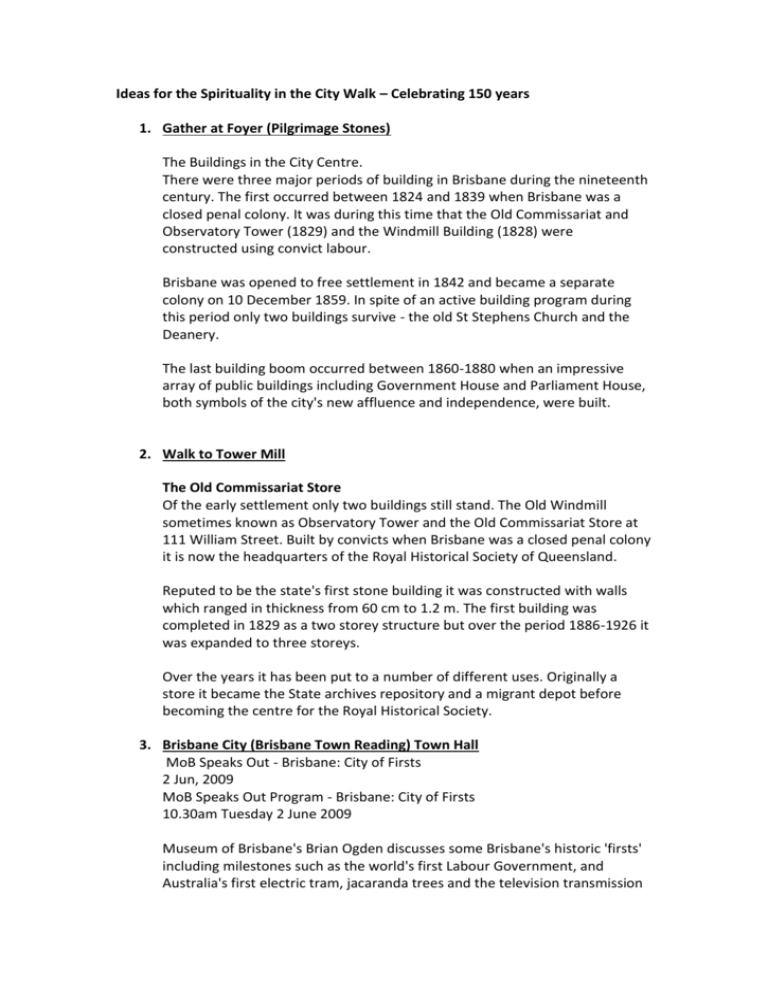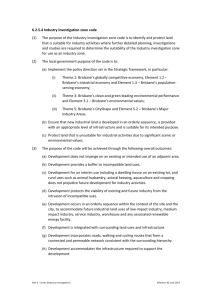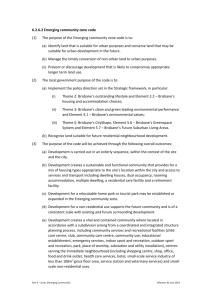Ideas for the Spirituality in the City Walk – Celebrating 150 years
advertisement

Ideas for the Spirituality in the City Walk – Celebrating 150 years 1. Gather at Foyer (Pilgrimage Stones) The Buildings in the City Centre. There were three major periods of building in Brisbane during the nineteenth century. The first occurred between 1824 and 1839 when Brisbane was a closed penal colony. It was during this time that the Old Commissariat and Observatory Tower (1829) and the Windmill Building (1828) were constructed using convict labour. Brisbane was opened to free settlement in 1842 and became a separate colony on 10 December 1859. In spite of an active building program during this period only two buildings survive - the old St Stephens Church and the Deanery. The last building boom occurred between 1860-1880 when an impressive array of public buildings including Government House and Parliament House, both symbols of the city's new affluence and independence, were built. 2. Walk to Tower Mill The Old Commissariat Store Of the early settlement only two buildings still stand. The Old Windmill sometimes known as Observatory Tower and the Old Commissariat Store at 111 William Street. Built by convicts when Brisbane was a closed penal colony it is now the headquarters of the Royal Historical Society of Queensland. Reputed to be the state's first stone building it was constructed with walls which ranged in thickness from 60 cm to 1.2 m. The first building was completed in 1829 as a two storey structure but over the period 1886-1926 it was expanded to three storeys. Over the years it has been put to a number of different uses. Originally a store it became the State archives repository and a migrant depot before becoming the centre for the Royal Historical Society. 3. Brisbane City (Brisbane Town Reading) Town Hall MoB Speaks Out - Brisbane: City of Firsts 2 Jun, 2009 MoB Speaks Out Program - Brisbane: City of Firsts 10.30am Tuesday 2 June 2009 Museum of Brisbane's Brian Ogden discusses some Brisbane's historic 'firsts' including milestones such as the world's first Labour Government, and Australia's first electric tram, jacaranda trees and the television transmission of a human face. Join us to learn more about some of Brisbane's fascinating 'firsts'. Please note this FREE event will be held in MoB's Helen Taylor Theatre. Brisbane City Hall Art Gallery and Museum One of historic Brisbane's most significant landmarks the City Hall Art Gallery and Museum complex combines King George Square, the Brisbane Administration Centre and the City Plaza Shopping Centre. The City Hall itself is an interesting example of an attempt to use English neo-classical architecture in a modern building. It uses Queensland brown-tinted freestone, marble, sandstone and timbers. The scale is impressive and full of old world charm. The main foyer inside King George Square, for example, uses ornate high vaulted ceilings, floor mosaics, and crafted timber and plasterwork to great effect. There is also a huge 16 m sculpture depicting Queensland protecting her citizens. The City Hall Art Gallery and Museum was opened by Queen Elizabeth II in 1977 and contains extensive displays of paintings, ceramics and photographs. The clock town, an amazing Italian renaissance number with rises 91 m above the City Plaza, provides excellent panoramic views of the city. 4. Walk to Customs House Customs House With its solid Corinthian columns and its greenish copper dome the Customs House stands beside the Brisbane River like a great Victorian matriach. Its position and prominence ensure that it is one of Brisbane's most impressive landmarks. It was built by John Petrie between 1886-89 and features twin pediments with heraldic shields and the words 'Advance Australia', a noble thought although, at the time of construction, there was no 'Australia'. 5. Walk to St John’s Cathedral St Johns Cathedral Located at 417 Ann Street, St Johns Cathedral may well lay claim to be Australia's oldest uncompleted building. This handsome Gothic cathedral, built in brick and Brisbane porphyry stone, was started in 1901 and, even today, the western section remains uncompleted. However to concentrate on the incompleteness of the building is to ignore its beauty. The architect John Loughborough Pearson was chosen to design the building. Unfortunately he died before the work was completed and his son finished the design. Although the cathedral was designed in a Gothic style it is more than a mere imitation. It is laid out like a crucifix and has some particularly impressive flying buttresses and fine rose windows. The construction of the cathedral has been a never ending saga. The foundation stone was laid in 1901, the first stage consecrated in 1910, and new bays completed in 1968. A model of how the cathedral will eventually look is located in the church. The Deanery Located at 417 Ann Street this gracious, two storey porphyry stone residence was designed by Andrew Petrie and built for Dr William Hobbs in 1853. It has a number of interesting claims to historical importance being one of the few remaining buildings built between 1842-59 and once serving as the Governor's residence (1859-62) while Government House was being built. Perhaps the Deanery's finest secular moment came in 1859 when the proclamation separating Queensland from New South Wales was read from the building's east balcony. 6. Walk to General Post Office: Remembering Women General Post Office Located at 261 Queen Street the General Post Office is located on the site of the city's original female convict barracks. Construction on the building was started in 1871 and completed in 1879. It is recognised as a fine example of a late Victorian Classical Revival building. When the Central Railway Station was built in Ann Street at the end of the nineteenth century the architects quite consciously placed its tower in the centre of the block so that the towers of the Post Office and the Railway were aligned. Although the project had started 59 years earlier it wasn't until 1930, with the creation of Anzac Square, that the entire streetscape was completed. As if to establish the perfect symmetry of the precinct the War Memorial Shrine, and the bronze equine statue commemorating the Boer War, was aligned with the towers of the General Post Office and the railway. 7. Walk to St Stephen’s Cathedral St Stephens Cathedral Located in Elizabeth Street St Stephens Church, sometimes known as Pugin's Chapel, is the city's oldest church. Built in 1850 and attributed to the English architect Auguste Welby Pugin it is a simple Gothic sandstone church. It was replaced by the new St Stephens Cathedral, which now stands next to the old building, in 1874. The 'new' cathedral was built between 1863-74 to a design by Benjamin Backhouse. OR Walk across Bridge to South bank visit St Mary’s (reading of History of Catholic Church in Brisbane) St Mary's, South Brisbane, in 1900 Collection: John Oxley Library, State Library of Queensland Image Number: 16357 4. Aborigines living in the Brisbane Area - Visit the QLD library section of Aboriginal dreaming prayer pit OR Mercy Sisters AllHallows'GRACED TRADITION' Brisbane Archdiocese Historical Exhibition Located in Mercy Heritage Centre All Hallows’ Convent, 547 Ann Street, City. Guided Tours. All Welcome. Hours: Monday & Friday 9.00am – 4.00pm. 1st Sunday of the Month 9.00am – 4.00pm with planned Lecture Series 2.00pm – 3.00pm RSVP for catering purposes. Group Bookings available other days. Ph 07 3831 2252. www.mercyheritage.com Admission Free. (Donations accepted)







